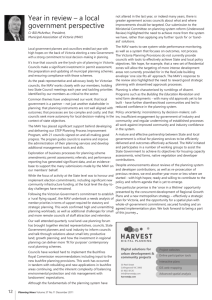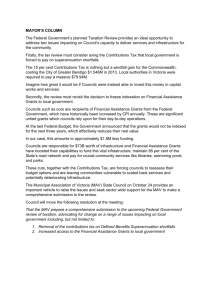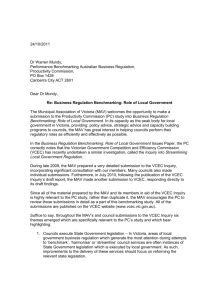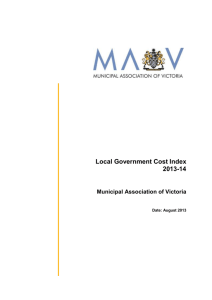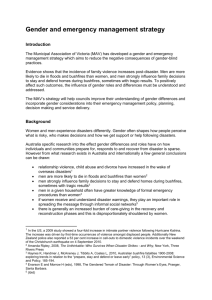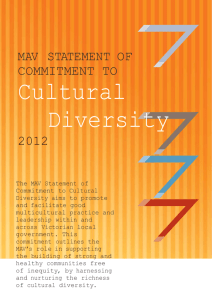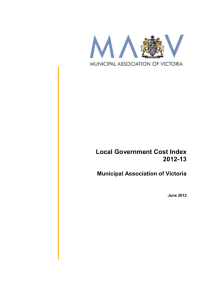Victorian Emergency Management Reform - White Paper
advertisement
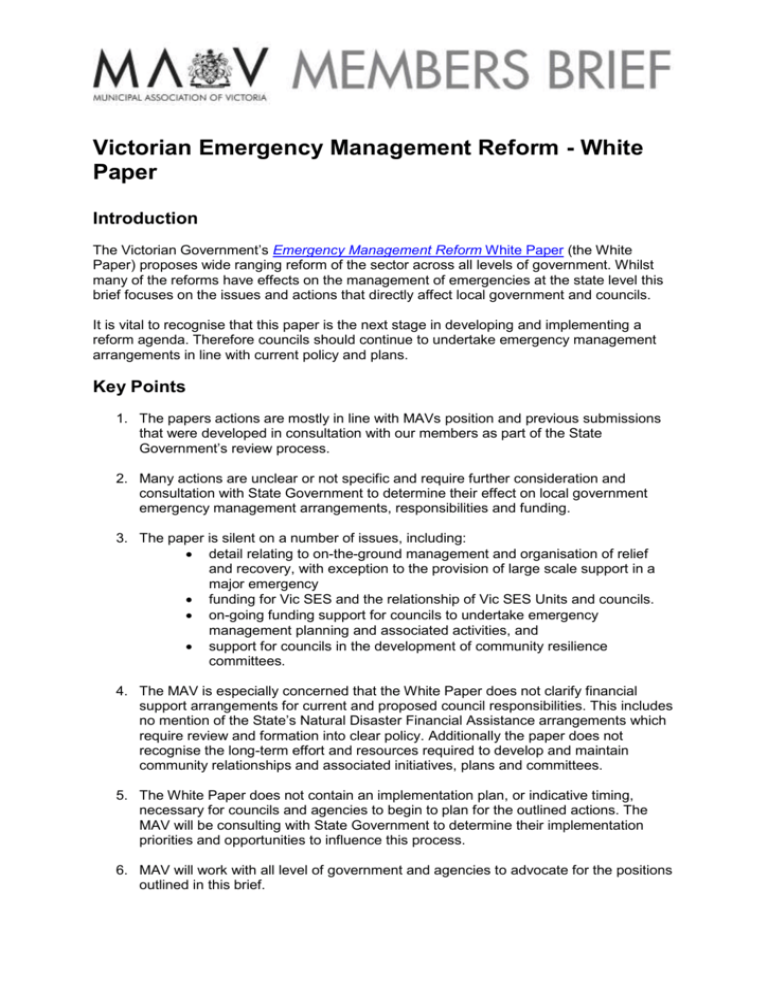
Victorian Emergency Management Reform - White Paper Introduction The Victorian Government’s Emergency Management Reform White Paper (the White Paper) proposes wide ranging reform of the sector across all levels of government. Whilst many of the reforms have effects on the management of emergencies at the state level this brief focuses on the issues and actions that directly affect local government and councils. It is vital to recognise that this paper is the next stage in developing and implementing a reform agenda. Therefore councils should continue to undertake emergency management arrangements in line with current policy and plans. Key Points 1. The papers actions are mostly in line with MAVs position and previous submissions that were developed in consultation with our members as part of the State Government’s review process. 2. Many actions are unclear or not specific and require further consideration and consultation with State Government to determine their effect on local government emergency management arrangements, responsibilities and funding. 3. The paper is silent on a number of issues, including: detail relating to on-the-ground management and organisation of relief and recovery, with exception to the provision of large scale support in a major emergency funding for Vic SES and the relationship of Vic SES Units and councils. on-going funding support for councils to undertake emergency management planning and associated activities, and support for councils in the development of community resilience committees. 4. The MAV is especially concerned that the White Paper does not clarify financial support arrangements for current and proposed council responsibilities. This includes no mention of the State’s Natural Disaster Financial Assistance arrangements which require review and formation into clear policy. Additionally the paper does not recognise the long-term effort and resources required to develop and maintain community relationships and associated initiatives, plans and committees. 5. The White Paper does not contain an implementation plan, or indicative timing, necessary for councils and agencies to begin to plan for the outlined actions. The MAV will be consulting with State Government to determine their implementation priorities and opportunities to influence this process. 6. MAV will work with all level of government and agencies to advocate for the positions outlined in this brief. Actions Directly Affecting Local Government CHAPTER 1 – COMMUNITY 1. b) Promote a framework to support, encourage and empower local initiatives to enhance resilience and guide agencies and local government in a consistent best practice approach to delivering community awareness, education and engagement activities 2. b) Support the development of Community Resilience Committees and plans that enable local communities to develop comprehensive all-hazards plans in line with municipal, regional and state plans The MAV supports measures that improve community resilience and agrees that the National Strategy for Disaster Resilience should serve as a foundation for our approach to emergency management reform. Local government is uniquely placed to support, improve and sustain community resilience. To achieve this, long-term commitment from all levels of government is necessary and councils will need sustained support to deliver local action. The White Paper supports this position at a high level; however the actions above lack sufficient detail to give local government comfort that: They will be supported, including financially, to help deliver sustainable community resilience The proposed framework and guidance facilitate opportunities for responsible agencies to roll out programs in a coordinated and strategic way to help build resilience, rather than maintaining the current disjointed delivery mechanisms. It is important that the State Government recognises the importance of council’s links to community groups which can act as a valuable tool to enable the delivery of measures to improve community resilience. The Victorian Flood Review recommended the development of resilience committees with Victoria Police undertaking a lead role. The White Paper clearly places this responsibility with local government. The scope of this undertaking requires significant development to ensure councils are adequately resourced to meet this on-going commitment. 2. a) Continue developing and implementing strategies to give community safety considerations greater prominence in land use planning and other regulatory processes MAV supports this action in principle. The MAV sees benefit in better integrated strategic land use planning and emergency management planning. Well determined planning ensures that risk is understood by both decision makers and the community and taken in to account in planning and building decisions. The MAV has previously called for the State Government to develop an all hazards strategy and detail hazard mapping. This would need to be reinforced by sufficient resources in both State agencies and local government. The mapping would need to be updated regularly and be reflected in planning schemes to inform land use planning decisions. An expedited process to introduce amendments to the planning scheme is also required. This approach has been adopted for bushfire in response to the recommendations of the Victorian Bushfire Royal Commission. 4. d) Review existing local government business continuity practices and, where necessary, help local governments prepare high quality, tailored business continuity plans in line with best practice and tailored to local government needs 4. e) Conduct a business continuity forum for local government to share best practice information and learn about developments in business continuity and crisis management planning (further forums will be considered following an evaluation of the initial forum) 4. f) Consult with the local government sector to develop strategies, mutual aid agreements and potentially legislation for a strategic partnership approach to help councils during extreme events Business continuity is an essential element of local government activity in emergencies. Many services delivered by municipalities must be maintained and enhanced during emergencies to assist the community to recover quickly. The recent MAV survey of emergency management capability in councils revealed significant variability in the standard and content of business continuity plans, and their relationship and integration with emergency management planning at the local level. The MAV supports this important opportunity for improvement, particularly the commitment of the state to provide assistance in this area. Therefore ensuring continuity or quick reinstatement of local government services and infrastructure must be a priority in an emergency. This should be recognised and councils should be funded for this and supported by other agencies. The engagement of the private sector in business continuity planning should also be incorporated into this process as the private sector also provides a number of vital services to communities. The White Paper identifies, by recommending removing the requirement for councils to operate Municipal Emergency Coordination Centres (action 15. e), that councils should not act as the primary providers of resources during an emergency event. Council resources should be more readily available to ensure the continuity of essential community services and the early initiation of recovery services. During extreme events council staff may be part of the affected community or may be redeployed to other emergency management roles. In these circumstances well defined formal collaboration agreements between councils and the State Government that provide resources to facilitate business continuity are vital. The actions above will help councils develop effective business continuity plans and provide councils with some support when their own resources are stretched. Formal mutual aid agreements and strategic partnerships between State and local government are beneficial. However regional agreements between adjoining councils with staff that have similar expertise delivering essential services to local communities will provide benefits that State Government cannot offer. Such regional agreements should be supported by State Government. 8. Work with local government, volunteer organisations and agencies to: a) Develop strategies to manage spontaneous volunteers during relief and recovery efforts, and b) Review protections (including insurance) for volunteers engaged to help in emergency events. The MAV welcomes these actions as the current system has proved unmanageable, requiring significant amounts of administrative support during a time when councils are busily engaged undertaking their emergency management responsibilities. The MAV is currently working with Volunteering Victoria to simplify the current volunteer management process in an attempt to remove much of the administrative burden from overstretched local governments and provide a more efficient and productive volunteer management system. The MAV will advocate for the incorporation of this work into the actions outlined above. The above actions should also recognise that in many municipalities alternate agreements already exist with local volunteer organisations which have the necessary expertise to coordinate volunteer management on council’s behalf. 9. In consultation with local government: a) Review all legislation that allocates emergency management responsibilities to local governments (including the Local Government Act 1989) to clarify local government’s roles in emergency management, taking into account work already undertaken by the Municipal Association of Victoria on the future role of local government in emergency management and its analysis of relevant legislation. The MAV fully supports this action and is pleased to see the view of councils, as expressed through our Role of local government in emergency management position paper, being supported in the White Paper. The MAV has already completed a range of preliminary work in this area and will look to further develop this in partnership with councils and the State Government to achieve realistic legislative reform. CHAPTER 2 – COLLABORATION 15. d) Clarify that incident controllers (with Emergency Management Team support) and not local governments will be responsible for resource provision during emergencies, and e) Remove the requirement for councils to maintain and operate Municipal Emergency Coordination Centres during emergencies. The MAV supports these actions. Logistics to support emergency response should be run out of the Incident Control Centre or equivalent (utilising the emergency management team concept) to improve coordination, provide more timely access to information and therefore provision of resources, and reduce confusion. Running a Municipal Emergency Coordination Centre (MECC) often results in council resources being unavailable for other essential activity such as: maintaining critical business services and systems restoring infrastructure supporting response agencies, and initiating relief and recovery services. There is still a need for individual councils to manage the incident from a council perspective, within their defined roles. Despite councils moving away from managing MECCs, MECC Central software will remain a valuable tool to support: council’s core business during an emergency, rather than the needs of other agencies incident management relief centre registration, and recovery, including case management. The White Paper is unclear on the future of the Municipal Emergency Resource Officer position within councils. It is important to note that councils should continue to operate MECCs under the current arrangements until a new process is developed and implemented. CHAPTER 3 – CAPABILITY 17. New emergency management planning arrangements will: a) Adopt an all-hazards all-agencies approach, and an increased focus on risk and operate at the state, regional and local government levels d) Consider a role for Regional Management Forums to support emergency management planning at the regional level g) Transfer responsibility for Municipal Emergency Management Plan auditing from Victoria State Emergency Service to the Inspector General for Emergency Management h) Clarify roles and responsibilities for local government, recognising that the Municipal Emergency Management Plan is a multi-agency plan MAV supports the White Papers actions regarding new planning arrangements. Many of the risk assessment and planning processes may be better managed at the regional level rather than at the state or local level, as the expertise within agencies is more appropriately sourced at that level, and often the same risk is shared by a number of neighbouring municipalities. In emergency planning, councils have fewer vested interests in specific hazards or defined aspects of emergency management than other agencies that do not have the information, resources or expertise to lead planning for specific hazards. However councils have the facilitation skills to draw people with specialist interests, skills and knowledge together to enable those people to develop an umbrella, ‘all hazard’, ‘all agency’ plan. Regional Management Forums may also be appropriate to support planning at the regional level. Municipal emergency management plans (MEMPs) are not ‘council’ plans. They are plans for the local, municipal or sub-regional area and many agencies are responsible for contributing to, and executing relevant sections of the plan. The White Paper action 17. h) must do more than recognise that MEMPs are multi-agency plans. Actions also need to be taken to provide support for MEMPs administration and that all-agencies must respond to the audit of the MEMP. These requirements may need legislative support to enforce participation and enable a cultural shift to a greater sharing of accountability for the delivery of planning outcomes. The new Inspector General for Emergency Management should also attempt to resolve these issues through the audit process. The MAV will continue to work collaboratively in this area, and is facilitating a number of councils participating in a trial of a new quality assurance model for the emergency management sector. Councils generally see benefits in working in partnership to develop more consistent approaches and to share planning approaches and operating arrangements. The White Paper also flags that: ‘opportunities for smaller municipalities to come together to form ‘clusters’ for emergency management planning purposes will be identified at the regional level’ and hazard specific plans at the local government level will be led by experts from relevant agencies. MAV strongly supports these statements; however actions regarding these topics are not explicitly outlined, nor is there any mention of support or funding to help develop regional clusters. The MAV is currently undertaking a cluster pilot program with four councils in the Bendigo area, funded through the Natural Disasters Resilience Grants Scheme. 25. develop a scalable model for quickly deploying an authority or body to coordinate the ongoing recovery arrangements after major emergencies with particularly devastating or far-reaching consequences. The MAV supports arrangements that provide greater certainty regarding what happens when a council is overwhelmed by an emergency. In very large-scale events, there may be a need for an extraordinary governance structure to oversee the expenditure of State and Commonwealth financial support (or donations) and additional resources. The tipping point will vary from council to council, and specific triggers may need to be established as part of this arrangement. The MAV recommends that a working group be established that includes local government representation to support the development of these triggers and arrangements. Previous representation by MAV centred on the need to work with councils on any support, and to utilise council community networks for engagement instead of establishing new ones. Any support arrangements should be in partnership with the council(s) affected. Legacy issues will also be a major focus of MAV’s advocacy. Previous MAV submissions and references The White Paper is very much in line with the submissions made by MAV on behalf of councils over the last two years as part of the review process. Importantly the paper broadly supports the MAV previously elicited first principles of: a focus on community resilience an all hazards, all agencies approach to planning, and three tiers of planning and operations The White Paper also recognises areas where MAV has advocated council does not have a role, specifically councils should not be: a primary coordinator of resource provision running Municipal Emergency Coordination Centre (MECC) in the current form responsible for hazard-specific plans For more detail on MAVs previous submission please see: The role of local government in emergency management – Position Paper o http://www.mav.asn.au/policy-services/emergencymanagement/Related%20documents%20%20EM/Role%20of%20local%20go vernment%20in%20emergency%20management,%20final%20position%20pa per.doc Emergency Management Green Paper: Towards a more disaster resilient and safer Victoria - MAV Submission, November 2011 o http://www.mav.asn.au/policy-services/emergencymanagement/Related%20documents%20%20EM/Submission%20on%20%2 7Towards%20a%20more%20disaster%20resilient%20and%20safer%20Victo ria%27%20Green%20Paper.docx Next Steps MAV has developed a draft work plan and is working to determine the State Government’s implementation priorities. Once the Government gives an indication of timelines and priorities for implementing actions in the White Paper we can begin to work in more detail with councils and engage with relevant authorities to ensure councils interests and views are represented. Background The Government released its emergency management Green Paper entitled Towards a More Disaster Resilient and Safer Victoria in September 2011, seeking submissions from all interested parties. Following the release of the Green Paper in September 2011, the MAV developed a draft response and circulated to all member councils for comment. At the same time, as part of the Improving Emergency Management in Local Government Program, broad consultation was undertaken to prepare a position paper on the future role of local government in emergency management. These consultations have contributed significantly to the content of MAVs position paper and submission to the Green Paper. The proposals in the White Paper are informed by the Final Report of the 2009 Victorian Bushfires Royal Commission, the Final Report of the Review of the 2010-11 Flood Warnings and Response, submissions on the Green Paper Towards a More Disaster Resilience and Safer Victoria and the Fire Services Reform Action Plan.

